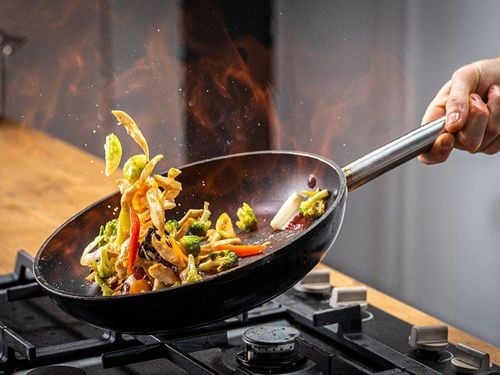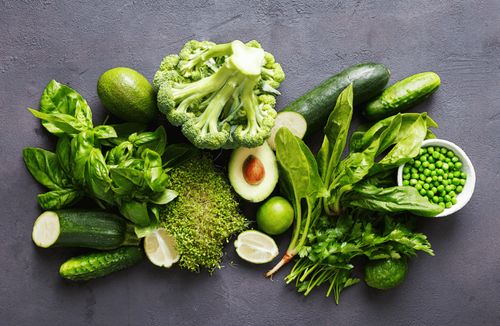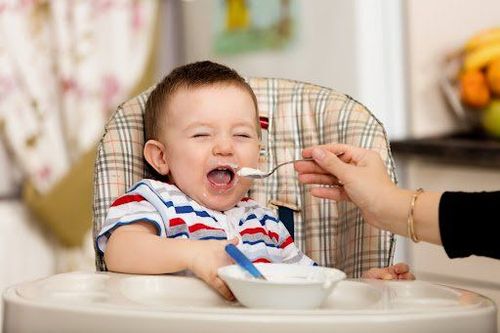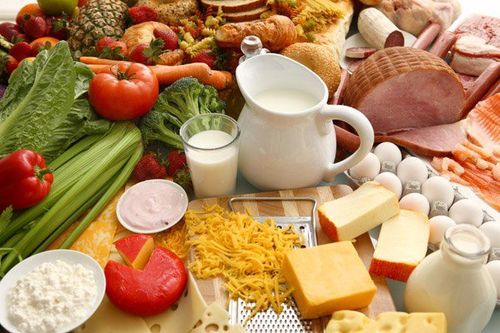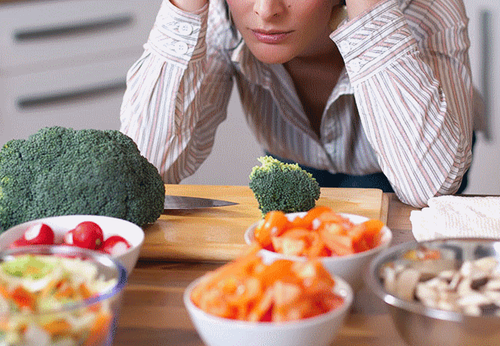This is an automatically translated article.
Vegetables are known as a healthy way to incorporate vitamins, minerals, fiber and antioxidants into your diet. Before eating fresh fruits and vegetables, it is recommended to rinse them thoroughly with water to remove unwanted residue on their surface. This article provides more information on best practices for washing fresh fruits and vegetables before eating them.
1. Why you should wash vegetables properly
Properly washing fresh fruits and vegetables with a good habit to follow to minimize the ingestion of harmful residues and germs. Many people handle fresh produce before you buy it from the grocery store or farmers market. You should note that not every hand that touches fresh produce has been sanitized.
Washing fresh fruits and vegetables before eating can greatly reduce the residue left on them in your kitchen.
Washing fresh fruits and vegetables is a proven way to remove germs and unwanted residue from their surfaces before eating.
2. The best product cleaning methods
Although fresh vegetables are still washed using ordinary water which has long been the traditional method of preparing fruits and vegetables before consumption, but due to the epidemic many people wonder if that is enough to actually clean them or not.
Some have advocated using common cleaning compounds such as soap, vinegar, lemon juice, or even commercial cleaners such as bleach as a cleaning measure.
However, health professionals as well as food safety experts, including the Food and Drug Administration (FDA) and the Centers for Disease Control (CDC), strongly encourage consumers to Consumers should not heed this advice and stick with cleaning vegetables with cold water.
The use of these substances can cause further health hazards and they do not necessarily remove the most toxic residues from the product. When using these products, it is possible to ingest commercial cleaning chemicals such as bleach, which can be deadly and therefore, absolutely do not use these compounds to clean food.
Furthermore, compounds such as: lemon juice, vinegar and product washes have not been shown to be more effective at cleaning products than plain water and can even leave residue on food.
Although some studies have suggested that using neutral electrolyzed water or a baking soda bath may be even more effective at removing some surface impurities from vegetables, the consensus Still continuing to be cool tap water is sufficient in most cases.
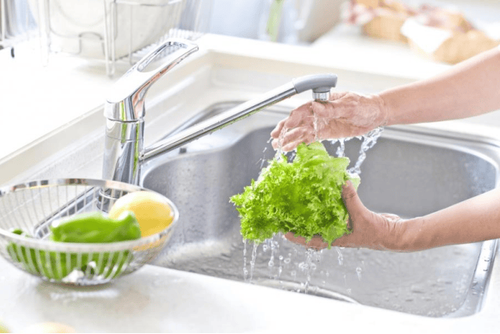
Rửa rau đúng cách giúp làm sạch thực phẩm một cách hiệu quả
3. How to wash fresh vegetables with water
Washing fresh fruits and vegetables in cool water before eating is a good practice to ensure food safety. You should also be aware that fresh produce should not be washed before you are ready to eat it. Washing fruits and vegetables first before storing them can create an easier environment for bacteria to grow.
Before starting to wash fresh fruit and vegetable produce, wash your hands thoroughly with soap and water. First, make sure that any utensils, sinks and surfaces you are using to prepare the product are also thoroughly cleaned.
Start by cutting off any obvious bruising or rotting areas on fresh produce. If you are handling a fruit or vegetable the first step is to apply a peel, such as: Oranges, wash before peeling to prevent surface bacteria from getting into the flesh of the fruit.
The general methods for washing fruit and vegetable products are as follows:
The product is stable. Harder-skinned fruits such as apples, lemons, and pears, as well as root vegetables such as potatoes, carrots and turnips, can benefit from brushing with a soft, clean bristled to remove residue from the skin. better pores. Leafy green vegetables. Spinach, lettuce, Swiss chard, leeks, and cruciferous vegetables such as Brussels sprouts and collard greens should all be peeled off the outermost layer, then dip in a bowl of cool water, drain and drain. , rinse with fresh water. Exquisite product. You can rinse berries, mushrooms, and other perishable crops with a steady stream of water and gently rub your fingers to remove grit. Once you've thoroughly washed fresh fruits and vegetables, pat them dry with a clean cloth or paper towel. More fragile fruit and vegetable products can be placed on a towel and patted or rolled around to dry them without damaging them. Before consuming raw fruits and vegetables, follow the simple steps above to minimize the amount of germs and substances that can get on them.
4. Myths about washing fruits and vegetables
Fruits and vegetables are important to a healthy diet , but they actually go from farm to table to your hands and who knows if that journey includes a stopover feet on the grocery store floor or not. So how should you wash vegetables before bringing them home?
4.1. Myth: Making sprays or soaps is the best way to clean your fruits and vegetables Fact: According to the Food and Drug Administration (FDA), washing fruits and vegetables with soap Commercial cleaning products, detergents or rinses are not recommended. The Centers for Disease Control and Prevention (CDC) also does not recommend washing fruits and vegetables with soap, detergents, or commercial product washes. Soap or detergent may remain on the product. The FDA has not evaluated the safety of residues left over from soaps and detergents if ingested.
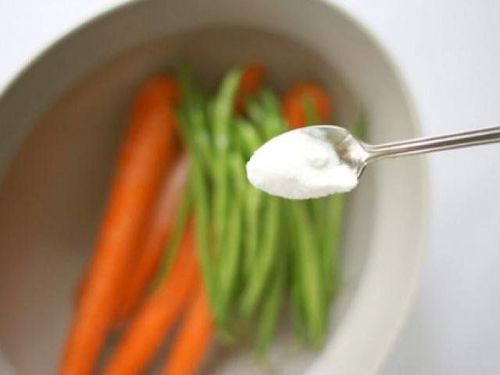
Rửa rau đúng cách khi bạn không sử dụng chất rửa để rửa rau
4.2. Myth: You need to wash produce before using Fact: Many pre-cut, bagged or packaged fruits and vegetables are pre-washed and ready to eat. This will be stated on the packaging and you can use the inside without further washing - the instructions used in the packaging facilities are very strict. If you wash produce, you're actually more likely to contaminate it because you'll be leaving them in many places around your kitchen - including plastic sinks.
4.3. Myth: Use diluted bleach to kill any germs on fresh produce Fact: Bleach can kill harmful microorganisms, but it should not be eaten! You should never wash your product with bleach or a diluted bleach solution.
5. The right way to wash vegetables
Experts recommend washing vegetables properly by cleaning gently rinsed under cold running water. If your produce has a hard surface, like a melon or pineapple, clean it with a stiff bristle brush under running water. The Centers for Disease Control and Prevention provides more detail on washing raw produce. They recommend washing fruits and vegetables before eating, cutting, or cooking them unless the packaging says the product has been washed (like packaged baby spinach). They also recommend rinsing or scrubbing produce under running water even if you don't eat the peels because dirt or skin germs can get inside fruits and vegetables when you cut them. Also, cut off any damaged or bruised areas before preparing or eating them. To dry fruits and vegetables, use a clean paper towel.
If you are working with something like spinach, leeks, or other green leafy vegetables that may have a lot of dirt, place the product in a large bowl of cold water, toss it around to remove any grit, Remove and let dry. hi. You want to make sure you don't spill gritty water back into the food; Try placing the colander inside the bowl so you can easily lift the leaves out. If the food is still gritty, repeat the process.
Practicing good food hygiene is an important health habit. Washing fresh produce helps minimize surface germs and residue that can make you sick. Concerns about the COVID-19 pandemic have led many to wonder if stronger washing methods, such as using soap or commercial detergents on fresh produce, are better. Medical experts are of the opinion that this is not recommended or necessary and can even be dangerous. Most fruits and vegetables can be rinsed with cool water and gently scrubbed just before serving. Fresh produce with more layers and surface area can be washed more thoroughly by soaking in a bowl of cool water to remove dirt particles. Fresh vegetables and fruits provide a number of healthy nutrients and should continue to be eaten, as long as safe cleaning methods are followed.
Please dial HOTLINE for more information or register for an appointment HERE. Download MyVinmec app to make appointments faster and to manage your bookings easily.
Reference source: healthline.com



